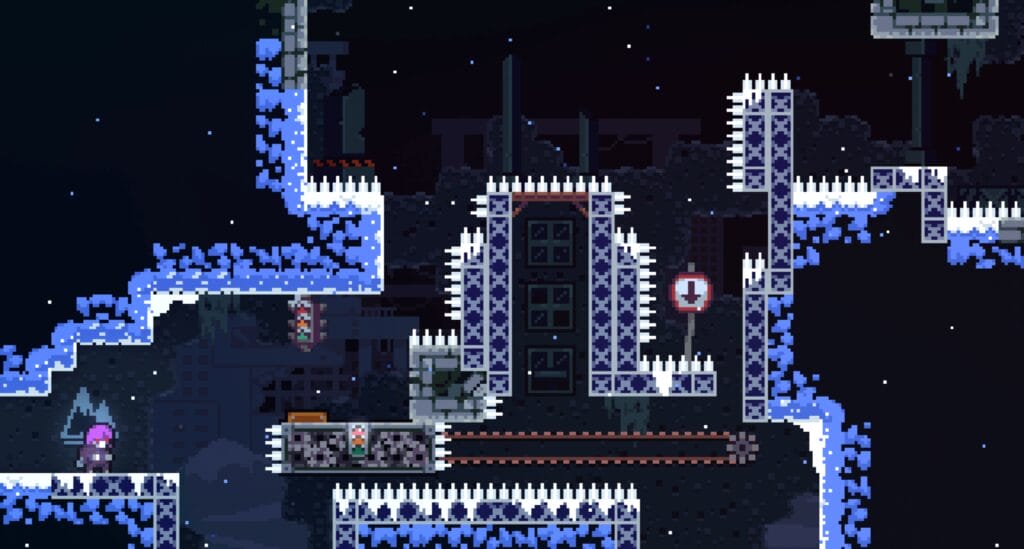Introduction to Engagement & Exploring Core Game Concepts in Mechanics
Engagement in games is crucial for player satisfaction and retention. Successful game design hinges on understanding the key elements that shape player experiences and determine how players interact with a game. These core elements are Mechanics, Dynamics, and Aesthetics (MDA), which together form the foundation of effective game design.
In this article, we’ll dive deep into each concept, explore their interplay, and provide examples, case studies, and key takeaways. We’ll also discuss the challenges of game design and look ahead to future trends shaping the industry.
Understanding Game Mechanics


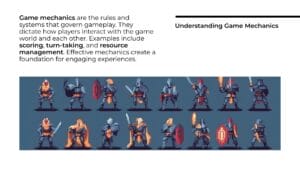

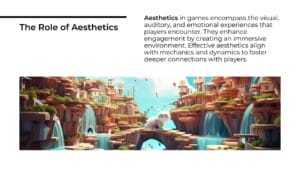






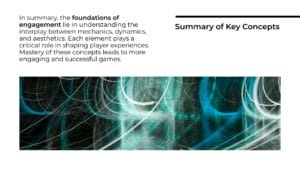
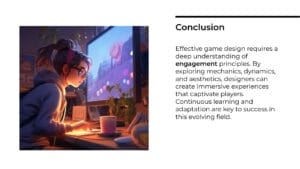
What are Game Mechanics?
Game mechanics are the rules and systems that govern gameplay. They dictate how players interact with the game world and each other. Mechanics encompass everything from scoring systems, turn-taking rules, and resource management to the basic movements of a character.
Examples of Game Mechanics
- Scoring Systems: In sports games, points are awarded for goals scored or tasks completed.
- Turn-Taking: Games like chess or board games often rely on turn-taking as a central mechanic.
- Resource Management: Strategy games may require players to manage resources such as gold, wood, or energy to progress.
- Character Movement: Platformers like Super Mario use jumping and running as core mechanics.
The Role of Mechanics in Engagement
Mechanics lay the foundation for engaging experiences. Effective mechanics are those that align with player expectations while offering a challenge that feels rewarding. If mechanics are too complex, players may feel overwhelmed; if too simple, they may lose interest.
Exploring Game Dynamics
What are Game Dynamics?
Game dynamics refer to the behaviors and responses that emerge from the interplay between mechanics and player actions. They encompass how players interact with the game and each other, driven by their motivations, strategies, and choices.
How Dynamics Shape Engagement
- Player Motivations: Dynamics tap into different player motivations, such as achievement, social interaction, or exploration.
- Emergent Gameplay: As players interact with mechanics, unique and unpredictable gameplay experiences can emerge. For instance, in The Sims, the combination of social needs and household management leads to diverse player-driven stories.
- Strategies and Tactics: Dynamics allow players to devise strategies to overcome challenges. For example, in StarCraft, resource management mechanics interact with unit control dynamics, resulting in varied strategic approaches.
Case Study: “Among Us”
- Mechanics: Core mechanics include task completion, player movement, and voting.
- Dynamics: Players must interact with each other to deduce who the imposter is, creating tension and social dynamics.
- Outcome: The blend of simple mechanics and complex social dynamics makes Among Us highly engaging.
The Role of Aesthetics in Game Engagement
What are Game Aesthetics?
Aesthetics refer to the sensory, emotional, and thematic experiences players encounter within a game. This includes visual design, sound effects, music, and narrative elements that create an immersive environment.
How Aesthetics Enhance Engagement
- Visual Appeal: High-quality graphics or a distinctive art style can draw players into the game world.
- Sound and Music: A captivating soundtrack can enhance the emotional tone of gameplay.
- Thematic Consistency: A game’s theme and setting should be reflected across all aesthetic elements, ensuring a cohesive experience.
Examples of Aesthetic Impact
- Journey: The minimalist art style and evocative soundtrack contribute to a profound sense of wonder.
- Cuphead: The 1930s-inspired art and animation give the game a unique aesthetic appeal, aligning with its challenging mechanics.
- The Legend of Zelda: Breath of the Wild: The game uses a naturalistic art style and ambient sounds to create an open-world experience that feels alive.
Integrating Mechanics and Dynamics
The Relationship Between Mechanics and Dynamics
The relationship between mechanics and dynamics is pivotal to creating engaging gameplay. Well-designed mechanics lead to positive dynamics, where player interactions naturally arise in response to the rules of the game.
Examples of Integration
- Dark Souls: The game’s challenging mechanics (e.g., enemy difficulty) lead to player dynamics such as cautious exploration and a strong sense of accomplishment.
- Tetris: The simple mechanics of fitting shapes together result in dynamic gameplay where players must constantly adjust their strategies as the game speeds up.
Analyzing the Impact
Understanding how mechanics influence dynamics helps game designers anticipate player behavior and shape experiences that are both enjoyable and challenging. Games that successfully integrate these elements maintain a balance of difficulty and reward, keeping players engaged over time.
Balancing Mechanics and Aesthetics
Why Balance is Crucial
Striking a balance between mechanics and aesthetics is essential for player satisfaction. If the mechanics are too complex or the aesthetics are lacking, players may feel disconnected and disengage. A harmonious blend ensures a captivating experience that keeps players invested.
Case Study: “Hollow Knight”
- Mechanics: The game features challenging platforming and combat mechanics.
- Aesthetics: The hand-drawn art and atmospheric sound design immerse players in the dark, mysterious world.
- Outcome: The balance between difficulty and artistic presentation creates a compelling experience that appeals to both casual and hardcore players.
Key Takeaways
- Mechanics Should Complement Aesthetics: The visual and auditory design should support the gameplay, not distract from it.
- Adapt Mechanics Based on Aesthetic Goals: If a game is meant to feel relaxing, the mechanics should not be too demanding.
Player Feedback and Iteration
Importance of Player Feedback
Feedback from players is vital for refining game mechanics and dynamics. Understanding how players interact with the game provides insights that can lead to more engaging gameplay. Iterative design allows developers to adjust mechanics, fix balance issues, and improve player satisfaction.
The Iterative Design Process
- Initial Development: Create the core mechanics and basic aesthetic framework.
- Playtesting: Allow players to experience the game and provide feedback.
- Refinement: Based on feedback, adjust mechanics, dynamics, and aesthetics.
- Repeat: Continue the cycle to fine-tune the game.
Examples of Iterative Design Success
- Fortnite: Regular updates and player feedback have shaped mechanics like building and shooting, as well as aesthetics like map design.
- No Man’s Sky: Initially criticized for lacking content, the game underwent significant changes based on player feedback, leading to a resurgence in popularity.
Challenges in Game Design
Balancing Complexity and Accessibility
Game designers must balance the need for engaging mechanics with the accessibility of those mechanics to a broad audience. A game that is too complex may alienate newcomers, while one that is too simple may not sustain interest.
Addressing Player Demographics and Preferences
Understanding the target audience is essential for crafting a game that resonates. Different player types (e.g., achievers, explorers, socializers, killers) have unique preferences that influence how they engage with mechanics, dynamics, and aesthetics.
Overcoming Design Hurdles
- Challenge: Balancing complexity vs. simplicity.
- Solution: Include difficulty settings or scalable challenges.
- Challenge: Creating replayability.
- Solution: Implement procedural generation or branching storylines.
- Challenge: Ensuring thematic consistency.
- Solution: Align all elements with the core theme or narrative.
Case Study: “The Witcher 3: Wild Hunt”
- Challenge: Balancing a massive open world with engaging content.
- Solution: Detailed side quests and a rich narrative maintained player interest.
- Outcome: The game became one of the most acclaimed RPGs for its blend of mechanics, story, and aesthetics.
Future Trends in Game Engagement
Emerging Technologies
The future of game engagement lies in emerging technologies and innovative design approaches. Trends like virtual reality (VR), augmented reality (AR), and AI-driven experiences are reshaping how players interact with games.
Potential Impact on Game Design
- Virtual Reality: Offers a deeper level of immersion, changing the way mechanics and dynamics function in a 3D space.
- Augmented Reality: Merges real-world and game elements, creating a new layer of player interaction.
- AI-Driven Experiences: Allows for more adaptive gameplay, where the game can respond to player behavior in real-time.
Examples of Trend Implementation
- Beat Saber (VR): Uses motion-based mechanics and dynamic feedback to create an engaging rhythm game.
- Pokémon GO (AR): Combines real-world exploration with virtual mechanics, fostering social interaction.
- AI Dungeon: Leverages AI to generate dynamic stories, offering a unique narrative experience every time.
Key Takeaways
- Mechanics, Dynamics, and Aesthetics are the core elements that shape player engagement in games.
- Mechanics create the rules and systems that players interact with, while dynamics emerge from these interactions.
- Aesthetics enhance the player experience through visuals, sound, and emotional tone.
- Balancing these elements ensures that games remain engaging, challenging, and enjoyable.
- Player feedback and iteration are crucial for refining game design and improving engagement.
- Future trends such as VR, AR, and AI will continue to evolve how games are designed and experienced.
Conclusion
Creating engaging games requires a deep understanding of mechanics, dynamics, and aesthetics. By mastering these concepts, designers can craft experiences that resonate with players, maintain their interest, and inspire long-term loyalty. Continuous learning and adaptation are key to success in this evolving field, as new technologies and trends continue to push the boundaries of what games can achieve.
Understanding these foundations and their interplay not only helps designers create more captivating games but also provides players with richer, more rewarding experiences. By embracing player feedback, tackling design challenges, and exploring emerging technologies, the future of game engagement is filled with exciting possibilities.
Additional Resources
- Books: The Art of Game Design: A Book of Lenses by Jesse Schell
- Online Courses: Game Design on Coursera, Unity Learn for beginners
- Communities: Reddit’s r/gamedev, Gamasutra, GameDev.net
Game Engagement FAQ
What are the core elements of engaging game design?
The three core elements of engaging game design are Mechanics, Dynamics, and Aesthetics (MDA).
- Mechanics are the rules and systems governing gameplay. They dictate how players interact with the game world and each other. Examples include scoring systems, turn-taking rules, resource management, and character movement.
- Dynamics are the behaviors and responses that emerge from the interaction between mechanics and player actions. They encompass how players interact with the game and each other, driven by their motivations, strategies, and choices.
- Aesthetics are the sensory, emotional, and thematic experiences players encounter in the game. This includes visual design, sound effects, music, and narrative elements that create an immersive environment.
How do game mechanics influence player engagement?
Mechanics lay the foundation for engaging experiences. Effective mechanics align with player expectations while offering a challenge that feels rewarding. If mechanics are too complex, players may feel overwhelmed; if they are too simple, players may lose interest.
What is the relationship between mechanics and dynamics?
Well-designed mechanics lead to positive dynamics, where player interactions naturally arise in response to the game’s rules. For example, the challenging mechanics in Dark Souls (e.g., enemy difficulty) lead to player dynamics such as cautious exploration and a strong sense of accomplishment.
Understanding how mechanics influence dynamics helps game designers anticipate player behavior and shape experiences that are both enjoyable and challenging. Games that successfully integrate these elements maintain a balance of difficulty and reward, keeping players engaged over time.
What role do aesthetics play in game engagement?
Aesthetics enhance engagement by creating an immersive and appealing experience.
- Visual Appeal: High-quality graphics or a distinctive art style can draw players into the game world.
- Sound and Music: A captivating soundtrack can enhance the emotional tone of gameplay.
- Thematic Consistency: A game’s theme and setting should be reflected across all aesthetic elements, ensuring a cohesive experience.
Why is player feedback important in game development?
Player feedback is vital for refining game mechanics, dynamics, and aesthetics. Understanding how players interact with the game provides insights that can lead to more engaging gameplay. Through an iterative design process, developers can adjust mechanics, fix balance issues, and improve player satisfaction based on feedback.
What are some challenges in game design?
Some common challenges game developers face include:
- Balancing Complexity and Accessibility: Finding the sweet spot between creating a game that is engaging and challenging without being too complex for new players.
- Addressing Player Demographics and Preferences: Understanding the target audience and catering to their preferences.
- Creating Replayability: Designing games that players will want to play multiple times.
- Ensuring Thematic Consistency: Maintaining a consistent theme and setting across all elements of the game.
How can emerging technologies impact game engagement in the future?
Emerging technologies like virtual reality (VR), augmented reality (AR), and AI-driven experiences have the potential to revolutionize game engagement by:
- VR: Offering deeper immersion by changing how mechanics and dynamics function in 3D space.
- AR: Merging real-world and game elements, creating a new layer of player interaction.
- AI: Enabling more adaptive gameplay by allowing the game to respond to player behavior in real-time.
What are some key takeaways for aspiring game designers?
- Understand the MDA framework: Mechanics, dynamics, and aesthetics are the building blocks of engaging game design.
- Balance is key: Strive for a balance between complexity and accessibility, challenge and reward, and mechanics and aesthetics.
- Embrace player feedback: Actively seek and use player feedback to improve your game.
- Stay up-to-date on trends: Keep learning and adapting to the ever-evolving landscape of game design and technology.









